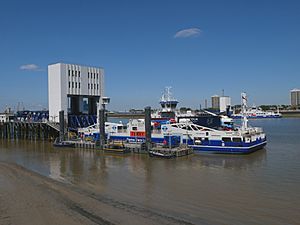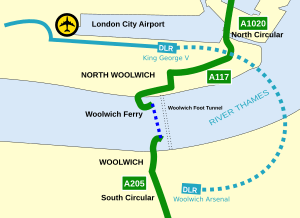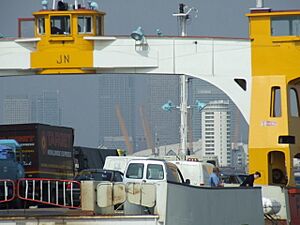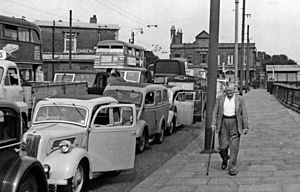Woolwich Ferry facts for kids

The south terminal of the Woolwich Ferry
|
|
| Locale | Woolwich, London |
|---|---|
| Waterway | River Thames |
| Transit type | Passenger and vehicle ferry |
| Owner | London River Services |
| Operator | London River Services |
| Began operation | 23 March 1889 |
| No. of lines | 1 |
| No. of vessels | 2 |
| No. of terminals | 2 |
| Daily ridership | 7,100 |
The Woolwich Ferry is a special boat service in East London. It's completely free to use! This ferry helps people and cars cross the River Thames. It connects Woolwich on the south side of the river with North Woolwich on the north side. London River Services, which is part of Transport for London (TfL), runs and pays for the ferry. About two million people use this ferry every year.
People have been crossing the Thames at Woolwich since the 1300s. A free ferry service started in 1889. This happened after tolls were removed from bridges in west London. More cars meant the ferry became very popular in the 1900s. It was important because there weren't many other bridges nearby. Fewer people walked on the ferry after a special foot tunnel was built. Also, the Docklands Light Railway (DLR) now goes to Woolwich Arsenal station. Even with new ideas like the Thames Gateway Bridge, the Woolwich Ferry will keep running as long as people need it.
Contents
How the Woolwich Ferry Works

The ferry connects Woolwich in the Royal Borough of Greenwich with North Woolwich in the London Borough of Newham. It also links two important roads in London: the North Circular and the South Circular.
On weekdays, the ferry runs from 6:10 AM to 8:00 PM. Two boats are usually working, so a ferry comes about every 10 minutes. On Saturdays, it runs from 6:10 AM to 8:00 PM with one boat. This means a ferry comes about every 15 minutes. The last boat from south to north leaves at 7:45 PM on Saturdays. On Sundays, it runs from 11:30 AM to 7:30 PM with one boat. The last south-to-north boat leaves at 7:15 PM.
The ferries can carry large trucks and other vehicles. They can take vehicles up to 4.7 meters (about 15 feet) high. They can also take vehicles up to 3.5 meters (about 11 feet) wide. The service is free for everyone.
Other Ways to Cross the Thames Nearby
If you are walking, the Woolwich foot tunnel is very close. It's about 100 meters (110 yards) to the east of the ferry. The Docklands Light Railway (DLR) also crosses the river. The Woolwich Arsenal station on the south side opened in 2009. King George V DLR station is on the north side, near the ferry dock.
For cars and trucks, the closest options are tunnels. The Blackwall Tunnel is about 2 miles (3.2 km) upstream to the west. The Dartford Crossing is about 10 miles (16 km) downstream to the east. Both tunnels have height limits for large trucks. Also, you have to pay a toll to use the Dartford Crossing.
History of the Ferry Service
Early Crossings
People have been crossing the Thames between Old Woolwich and North Woolwich for a very long time. Records from 1308 show a ferry service was already running. The business was sold for £10 that year. Later, in 1320, it was sold for 100 silver marks.
More people needed to cross the river after the Royal Arsenal was built in 1671. The army even started its own ferry in 1810 to move troops and supplies. A company tried to run a commercial ferry in 1811, but it closed in 1844. Later, a railway company ran three steam ferries. But these boats were not enough for everyone who wanted to cross.
In 1880, people in Woolwich talked about starting a local steam ferry. But it seemed too expensive. The Metropolitan Board of Works had made bridges in west London free. So, it was suggested they should pay for a free crossing in east London too. In 1884, the board agreed to buy two steam ferries. Each boat cost £10,650. Sir Joseph Bazalgette, a famous engineer, was asked to design the ferry system.
Modern Ferry Service
The free ferry service officially opened on March 23, 1889. The first boat was called the Gordon. Two days before it opened, the London County Council (LCC) took over from the Metropolitan Board of Works. So, Lord Rosebery opened the service instead of Bazalgette. Another boat, the Duncan, started running on April 20.
By the late 1920s, more cars meant the ferry was getting very busy. A new bridge was suggested, but it was thought it might be a target during wartime. So, a third ferry boat was added instead. Because there were no other easy ways to cross the river, the Thames felt like a big barrier for people in East End of London. This lack of crossings led to plans for the Dartford Crossing further downstream.
By the 1950s, it was sometimes faster to drive through the Blackwall Tunnel than wait for the ferry. In April 1963, the old paddle steamers were replaced. The ferry service was updated to a modern "roll-on/roll-off" system. This made waiting times much shorter. The LCC ran the ferry until the Greater London Council (GLC) took over in 1965. New concrete terminals were built in 1964 and opened in 1966. These terminals can work even when the river's water level changes a lot.
After the GLC was removed in 1986, the government took over the ferry. They hired the London Borough of Greenwich to run it. Later, Transport for London (TfL) became the owner. But the London Borough of Greenwich still operated the ferry for TfL.
In 2008, the London Borough of Greenwich decided to stop running the service. So, a company called Serco took over. Then, in 2012, Briggs Marine started running the ferry. They signed a £50 million contract for seven years.
In 2014, TfL started to improve the ferry service. They fixed the piers and ordered two new boats in 2016. These new boats were built in Poland by Remontowa and designed by a Norwegian company. They are diesel-electric hybrid boats. They have lots of space for cars and special areas for cyclists. They can carry 150 passengers. In 2017, it was announced the new boats would be named after Dame Vera Lynn and Ben Woollacott. Dame Vera Lynn was a singer from nearby East Ham. Ben Woollacott was a 19-year-old ferry worker who sadly died in an accident in 2011.
In October 2018, the ferry service stopped for four months for major repairs to the piers. The foot tunnel stayed open. The ferry started running again on February 1, 2019.
After Briggs Marine's contract ended in December 2020, London River Services took over. Since then, the ferry runs fewer hours. It now ends at 7 PM on weekdays instead of 10 PM. Also, only one of the two new ferries has been used since 2020. TfL says this is because of staff shortages.
Incidents
On August 3, 2011, a 19-year-old ferry worker named Ben Woollacott died. He fell off the boat into the River Thames. A report later said that unsafe ways of working caused his death. When two new ships were bought in 2018, one was named after him to remember him.
The Ferry Boats

The first ferries were paddle steamers called Gordon, Duncan, and Hutton. They were named after famous people like General Gordon and Professor Charles Hutton. Each boat had a powerful engine.
Over time, these old boats were replaced. In 1923, The Squire was added, named after a former mayor of Woolwich. In 1930, Will Crooks and John Benn joined the fleet. Will Crooks was a local Member of Parliament. John Benn was a member of the London County Council.
In 1963, three new boats were built in Scotland. They were named James Newman, John Burns, and Ernest Bevin. These boats had special systems to make them easy to steer. They were powered by diesel engines. In 2014, Transport for London started putting artwork on the ferry boats. These boats stopped running on October 5, 2018, and were later sold to be taken apart.
Two brand new boats, the Ben Woollacott and the Dame Vera Lynn, arrived in October 2018. They started service on February 1, 2019. However, these new boats have had many technical problems. This has caused the ferry to close or run less often. The Mayor of London, Sadiq Khan, even apologized in 2019, saying the new ferries "aren't good enough."
How Many People Use the Ferry?
The ferry usually carries about two million people each year. This number includes drivers and passengers in vehicles. In 2012, the ferry carried about 20,000 vehicles and 50,000 people every week.
At busy times, cars often have to wait in a line for the next ferry. Over the years, improvements have been made to help manage these queues.
For people walking, buses connect to both ferry terminals. There is a small bus station on the north side. However, some people who walk choose to use the foot tunnel instead. Between 1983 and 1985, about 300 foot passengers used the ferry daily. When the Docklands Light Railway (DLR) was extended to Woolwich in 2009, it gave people another way to cross the river. This led to fewer foot passengers using the ferry.
The Ferry's Future
The Woolwich Ferry is one of the few ways to cross the Thames by road in East London. As long as people need a vehicle ferry, it will likely continue to run. Stopping it would require changing an old law from 1885.
There were plans for a new bridge, the Thames Gateway Bridge, near the ferry in 2004. But this project was cancelled in 2008. In 2012, the Mayor of London, Boris Johnson, announced a new ferry service called the Gallions Reach Crossing. This was planned to run further east. However, it did not happen. Now, there are ideas for a new bridge or tunnel in that area instead. TfL says the Woolwich Ferry will keep going as long as there are no other options. There are no plans to stop the service right now.
The ferry is free because of the 1885 law. To charge money for the ferry, this law would need to be changed. It is possible that tolls might be added in the future, perhaps with other projects.
Ferry in Movies
The Woolwich Ferry has appeared in some TV shows and movies. The boat called the John Benn is shown being destroyed by a monster in the film Behemoth, the Sea Monster. A detailed model of the ferry was used in the movie.



